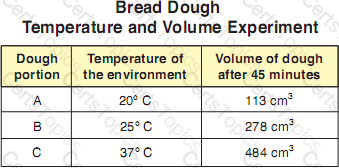Yeast is a fungus that is used in making bread. As the yeast cells reproduce and feed, they ferment sugars to produce ethyl alcohol and carbon dioxide gas. The carbon dioxide forms bubbles in the dough, causing the dough to rise. How fast the dough rises depends on temperature.

Three portions of dough weighing exactly the same are allowed to rise for 45 minutes at three different temperatures. At the end of forty-five minutes, the volume of each portion is measured. The results of the experiment are listed in the table at the left.
Based on the chart, which statement is an accurate conclusion?
If you had a freshwater fish tank in your home, which type of algae would most likely survive in that type of environment?
To begin a fission reaction, a neutron is shot at high speed into the nucleus of an atom of Uranium-235. This process releases a large amount of energy contained within the nucleus. The diagram above illustrates this process as well as possible by-products.

Based on the diagram and information, which statement best describes the fission reaction shown?
The widespread use of antibiotics has created a frightening threat to our safety. While antibiotics have offered life-saving treatment for countless diseases, their misuse and overuse have contributed to the evolution of deadly bacteria that are resistant to treatment. Although there is a reluctance to give up the demand for antibiotics, most people accept scientists’ warnings of impending catastrophe.
Which choice best explains why doctors now prescribe antibiotics less often than in the past?